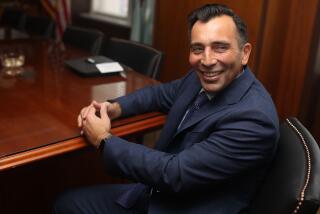Keating’s Odds of Prison Fade With Memories
- Share via
PHOENIX — Pat McMahon was primed for what he was sure would be a wave of angry callers to his top-rated talk show on KTAR-AM.
After all, Charles H. Keating Jr., the once powerful and enigmatic builder of some of the city’s landmarks who went on to become a national symbol of greed and fraud, had won his release from prison the previous evening.
Callers had once spent hours chewing over every morsel of news about Keating, who was convicted of looting Lincoln Savings & Loan in Irvine, causing one of the nation’s worst thrift failures, and defrauding thousands of Southern California investors.
His early release, pending a hearing on his motion for a new trial, came after he served 4 1/2 years of a 12 1/2-year sentence, and that unexpected news could be counted on to generate the heated talk that makes for lively shows.
But after McMahon opened the lines, only a dozen calls came into the station. He ended up spending only half of his two-hour program on Keating.
“They were totally unforgiving; not one call was sympathetic to Charlie,” the talk-show host said. “But, even if they want Charlie to spend more time in jail, what can they do about it? People are passionate about an issue as long as they feel they can do something about it.”
Could it be that the very personification of the thrift industry’s arrogance and political clout in the high-flying 1980s is passe?
Could it be that Keating, held up by prosecutors as the kingpin of the thrift debacle that is costing taxpayers $150 billion, could win a new trial and no one would care?
Could this be the last major chapter in the Lincoln Savings saga that stretches back more than a dozen years, ruining political careers and shattering the lives of so many elderly Southern Californians, the core of investors who lost $285 million in Keating’s financial dreams?
Many, like William D. Davis, a former California S&L; commissioner, believe it is, even though a federal judge won’t rule on the new trial motion until Nov. 25.
“I think he did the deeds and deserves the time in jail,” Davis said. “Yet he’s out, and I don’t think he’ll ever go back.”
Even in California, where investors keep alive the fire of indignation, memories are growing short.
“I talked to a guy on the street and mentioned Charlie Keating,” Davis said, “and he says, ‘Charlie who?’ Four years ago, everybody knew him.”
But if memories of Keating are dimming, the legacy of the decade-long thrift crisis is logged in state and federal laws and stiffer regulations as a warning never to let the nation’s financial industry again be brought to its knees.
Deregulation, ushered in under President Ronald Reagan in 1982, opened the field to any operator who could raise $1 million or so to start a thrift. Regulators, especially in California, encouraged a wide range of risky investments for free-spending entrepreneurs who gambled with a limitless supply of other people’s money--federal insured deposits.
The collapse was inevitable, and costly. The taxpayer tab to clean up Lincoln alone is now estimated at $3 billion. In the wake of the industry debacle, and Lincoln’s failure in particular, Congress and regulators revamped laws, rules, procedures and manuals to halt such practices as the sale of an institution’s own stock and bonds inside its branches.
“I think we can stop the next Charlie Keating,” said John F. Robinson, regional director in San Francisco of the Office of Thrift Supervision, the federal thrift regulatory agency. “There always will be a risk that someone who wants to commit fraud will find ways to do it. But we certainly should be able to avoid extremely expensive failures.”
*
Despite the subsiding anger toward Keating, he clearly is not a welcome figure back in Phoenix, a place the one-time Cincinnati lawyer and real estate developer adopted as his home 20 years ago.
He came into Phoenix in 1976 with a wide smile and friendly handshake to turn around troubled Continental Homes Inc., the home-building arm of his mentor, Cincinnati financier Carl Lindner. He created American Continental Corp., eventually sold Continental Homes and, in 1984, bought Lincoln.
Using the liberalized investing powers in California, the thrift industry’s most wide-open state, he transformed the traditional mortgage-making institution into a deregulation dynamo.
He put Lincoln’s federally insured deposits into hotels and resorts, corporate takeover attempts and foreign currency trading. And he dumped about $2 billion into Arizona real estate, most of it desert dust that he envisioned as a safe, clean, pornography-free community he called Estrella, southwest of Phoenix.
Tall, dapper and charming, Keating passed out huge sums of money to civic and charitable causes. He escorted Mother Teresa around in one of his company’s three private jets and providing her Calcutta mission with $2 million in donations.
But he also was a determined businessman who would not be cowed by others, much less the federal government.
Keating never held an official position at Lincoln, ruling instead from afar as chairman of American Continental in Phoenix. He was the deal maker, and nothing happened without his approval.
Regulators charged, however, that many of his deals were sham transactions designed to pump up the value of Lincoln assets so that more money could flow up to the corporate offices and into the pockets of Keating and his family.
Keating fought the government tenaciously, blaming regulators for failing to understand his business and for targeting him as part of vendetta over his end-runs around them.
His political clout was such that he managed to get a group of U.S. senators to meet twice with thrift regulators in an effort to bring to an end an unusually lengthy federal audit of Lincoln. The Keating Five, as they became known, were later chastised by the Senate Ethics Committee for taking Keating’s money while doing his bidding.
But Keating was unapologetic. When asked shortly after Lincoln’s failure about whether his donations influenced politicians, he drew his imposing 6-foot-5 frame up and said, “I want to say in the most forceful way I can: I certainly hope so.” He went on to explain that that is how the “system we call democracy works.”
*
Now the system called justice seems headed into its last lap for Keating, and the one-time national collegiate breaststroke champion is trying to turn it into a race.
After Lincoln’s collapse, Keating faced a host of civil and regulatory actions that seemed to border on overkill. They were overshadowed, though, by the criminal cases.
Keating was convicted first in state court in 1991 for violating California securities law, and was sentenced to 10 years in prison. In early January, 1993, he was convicted in federal court of racketeering, conspiracy and fraud.
But last April, a federal judge threw out the state conviction, saying it was based on “nonexistent and erroneous legal theory” and erroneous jury instructions. In June, an appeals panel ordered a hearing on jury misconduct allegations arising from the federal trial. It was after hearing closed-door testimony from jurors Oct. 3 that U.S. District Judge Mariana R. Pfaelzer, who presided over the federal trial, ordered Keating’s release.
Now, even lawyers for investors and industry experts concur in former S&L; commissioner Davis’s doubts that Keating will ever go back to prison.
“I’m not sure it serves any useful purpose to pursue him,” said Ronald Rus of Irvine, one of the lead lawyers for American Continental investors. “The people who were his victims know what happened and got enough back [in settlements with Lincoln accountants and lawyers] to get on with their lives.”
While many question the wisdom of spending millions of dollars more to pursue Keating through another trial, federal prosecutors are eager to do it. “There was a lot of money lost and a lot of people hurt,” said one prosecutor familiar with the case.
Prosecutors also think that Pfaelzer may not be so ready to order a new trial.
“She simply could be making a record showing that she has an open mind,” the prosecutor said. “She can appear neutral while denying his motion, and she also could let him stay out on bail pending his appeal.”
Legal wrangling aside, prosecutors, regulators and American Continental investors will never forget or forgive Keating.
“Everybody’s probably had enough of Keating,” Davis said. “The time, the expense, the commitment is too much. If you’re talking about the guy on the street, he’s probably forgotten Keating. If you’re talking about me, no; and if you’re talking about the bondholders, absolutely not.”
*
Bored though Phoenix may be with Keating, residents still have strong opinions about him.
From talk shows to shopping centers to local pubs, they can’t understand why he got out of prison and think he should serve the rest of his term.
“He had some marvelous ideas. Had they not been all a scam, they would have done a lot of good,” said Tom Martin, a retired auto finance executive.
Paradise Valley resident Dick Anderson disdains the one-time land baron. He is irked, among other things, by Keating’s attempt to ban pornography at Estrella with a clause inserted in the development’s covenants, codes and restrictions for residents.
“He always had a God-syndrome, and he still thinks he’s God,” Anderson said. “I don’t need Charles Keating to tell me my morals, especially when he sold junk bonds to the elderly.”
Though Keating, 72, declines to be interviewed, he made a few public remarks after his release that irritated Arizonans.
“I believe I’ve added 10 to 15 years to my life,” he told the Arizona Republic. “I spent 3 1/2 hours a day exercising while I was there. My blood pressure is what it was when I got out of the Navy in 1948.”
That galled Bill Babo, a long-time Phoenix resident. “He’s bragging, ‘You can’t hurt me. I’m indestructible.’ ”
Babo said he long has perceived Keating as a high-flyer, an awkwardly flamboyant businessman who “always did ostentatious things,” like pulling a secretary aside during a television interview to raise her pay to $100,000.
Indeed, said talk-show host McMahon, the would-be tycoon seemed almost obsessed with money.
Keating, he said, always talked about how much this hotel cost or what he spent on Estrella’s artificial lakes and roads. On a private tour of the palatial Phoenician Resort before it opened in 1988, a Keating aide told him that the Persian rugs were sent back because they didn’t have the right content of silk. “That was pure Charlie,” he said. “Everything about the Phoenician was just an incredible show of flaunting the excesses.”
Such spending habits were rampant among the former owners of the more notorious thrift failures. But fraud was only a smaller part of the thrift debacle, and Keating’s actions don’t always help explain what happened to the industry.
“The S&L; problem is a really complicated issue to me,” said James Overrein of Scottsdale, as he took a break from shopping last week in the wealthy Phoenix suburb of Paradise Valley, Keating’s home. “I don’t know if the public can ever know enough about finances to understand what happened.”
Overrein, a creative manager at a local advertising agency, believes Keating “did a lot of good things” in the Phoenix area, like erecting the Phoenician and starting Estrella.
“I’m sorry to see him suffer the legal problems he’s had,” Overrein said, “but by the same token, I feel sorry for those who lost money in his company.”
More to Read
Sign up for Essential California
The most important California stories and recommendations in your inbox every morning.
You may occasionally receive promotional content from the Los Angeles Times.













